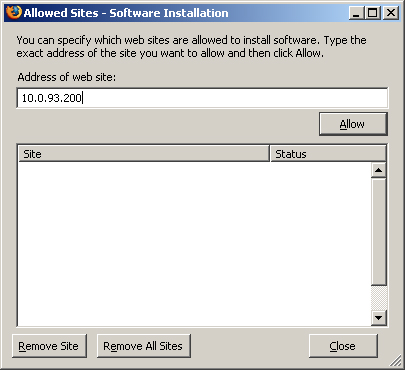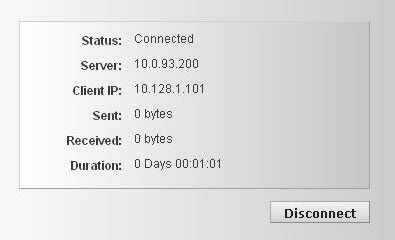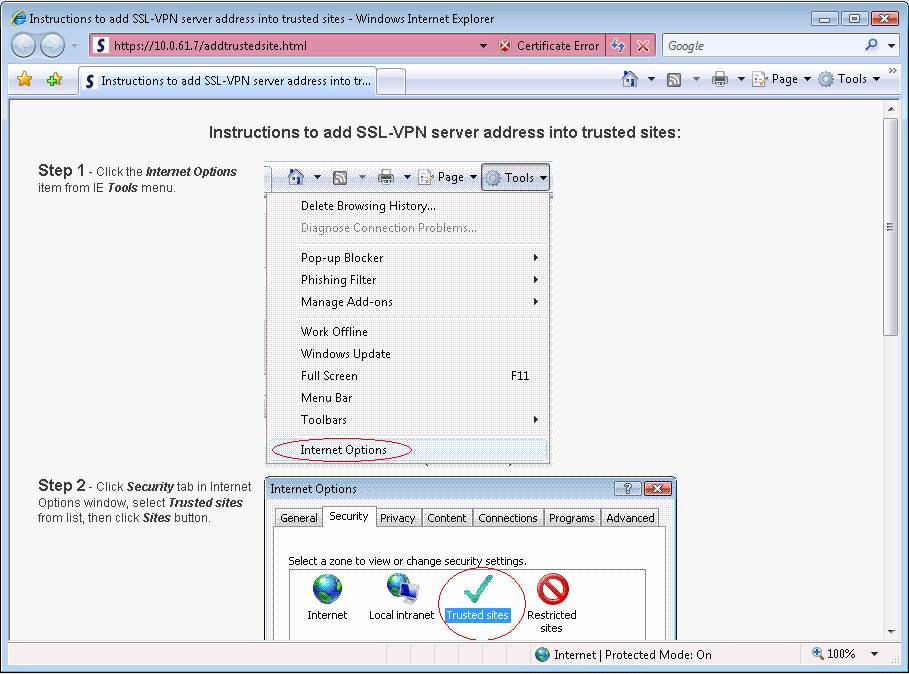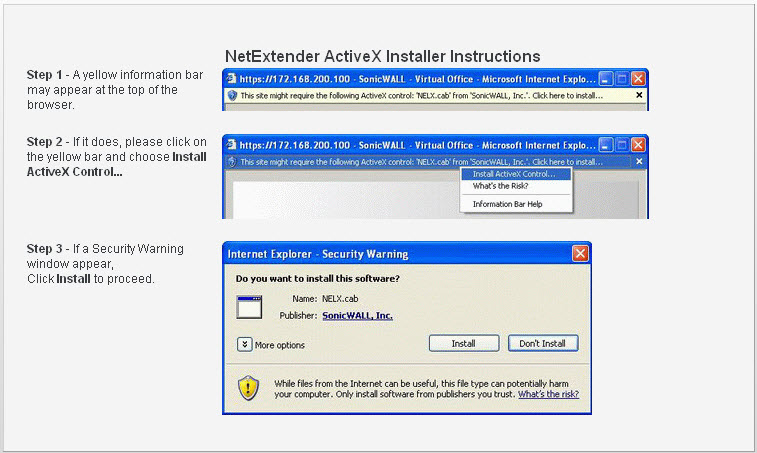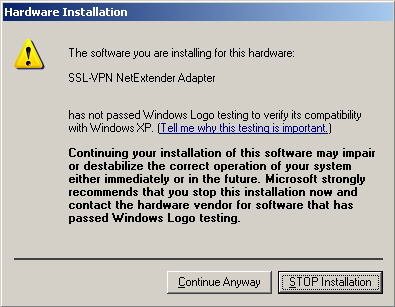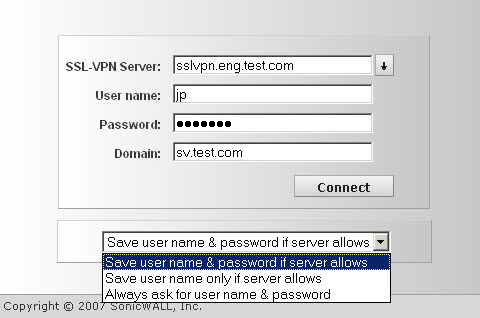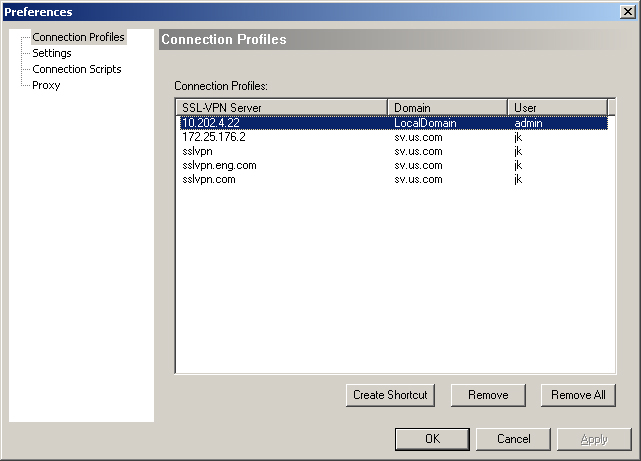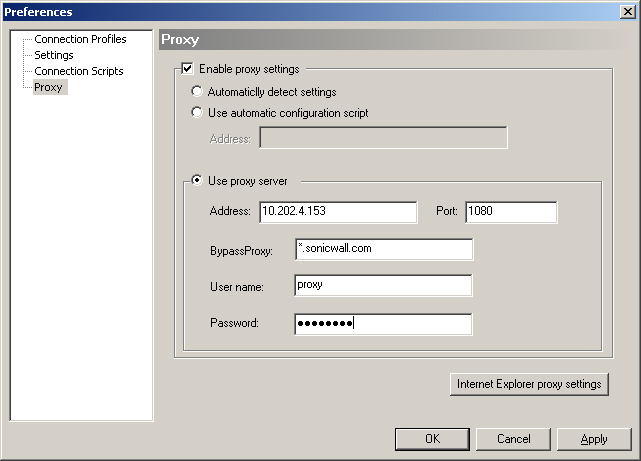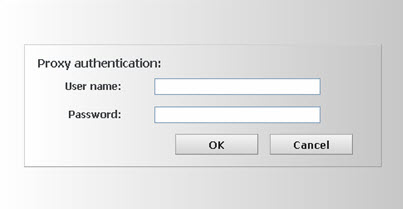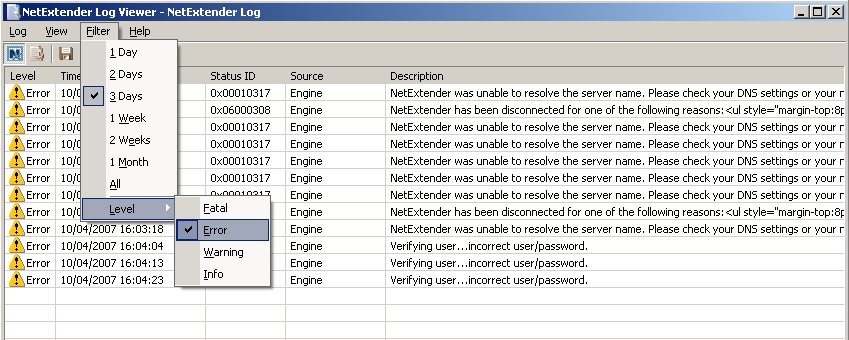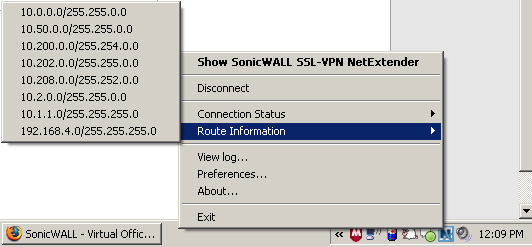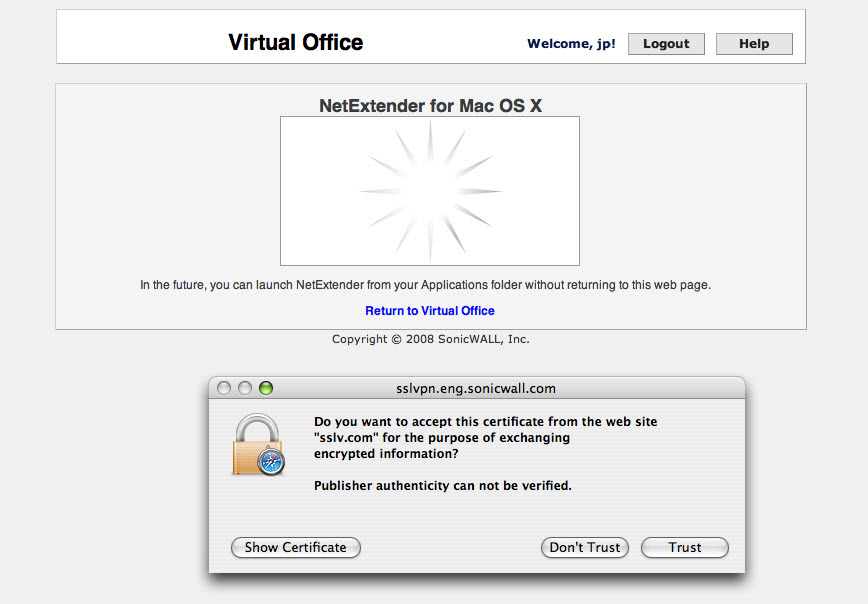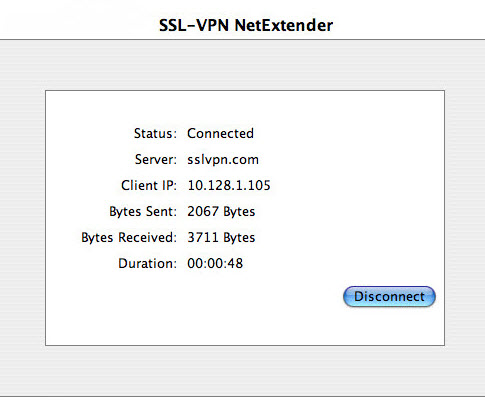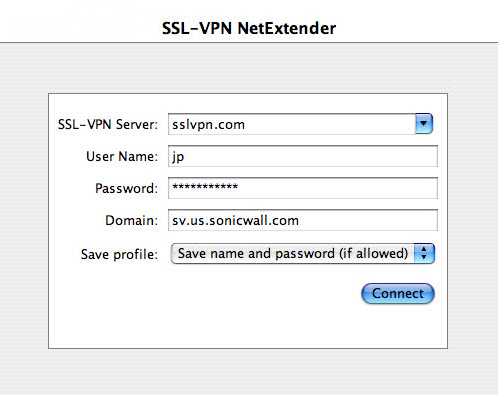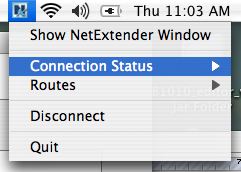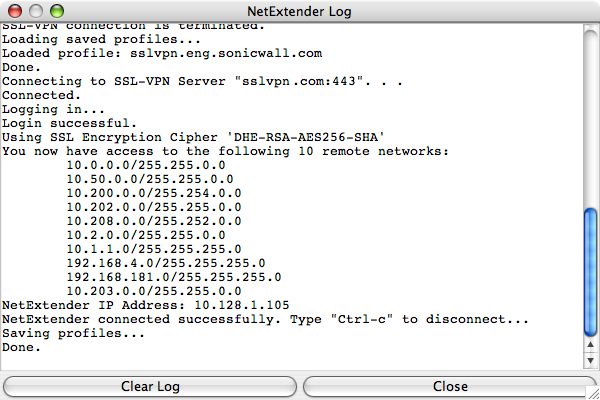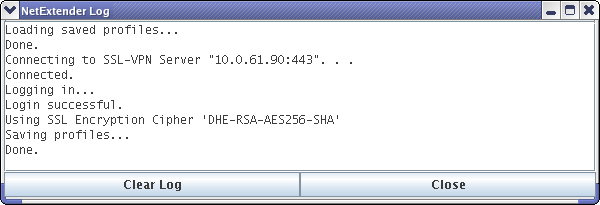|
1
|
|
2
|
Click the NetExtender button.
|
|
3
|
|
4
|
The Allowed Sites - Software Installation window is displayed, with the address of the Virtual Office server in the address window. Click Allow to allow Virtual Office to install NetExtender, and click Close.
|
|
5
|
|
6
|
The Software Installation window is displayed. After a five second countdown, the Install Now button will become active. Click it.
|
|
8
|
When NetExtender completes installing, the NetExtender Status window displays, indicating that NetExtender successfully connected.
|
|
9
|
Review the following table to understand the fields in the NetExtender Status window.
|
|
1
|
In Internet Explorer, go to Tools > Internet Options.
|
|
2
|
Click on the Security tab.
|
|
3
|
|
4
|
Enter the URL or domain name of your firewall in the Add this Web site to the zone field and click Add.
|
|
5
|
|
1
|
|
2
|
Click the NetExtender button.
|
|
4
|
Click Instructions to add SSL VPN server address into trusted sites for help.
|
|
5
|
In Internet Explorer, go to Tools > Internet Options.
|
|
6
|
Click on the Security tab.
|
|
7
|
|
8
|
Enter the URL or domain name of your firewall in the Add this Web site to the zone field and click Add.
|
|
9
|
|
10
|
Return to the SSL VPN portal and click on the NetExtender button. The portal will automatically install the NetExtender stand-alone application on your computer. The NetExtender installer window opens.
|
|
12
|
If a warning message that NetExtender has not passed Windows Logo testing is displayed, click Continue Anyway. SonicWALL testing has verified that NetExtender is fully compatible with Windows Vista, XP, 2000, and 2003 and later.
|
|
13
|
When NetExtender completes installing, the NetExtender Status window displays, indicating that NetExtender successfully connected.
|
|
1
|
Navigate to Start > All Programs.
|
|
2
|
Select SSL VPN NetExtender folder, and then click on SonicWALL SSL VPN NetExtender. The NetExtender login window is displayed.
|
|
3
|
The IP address of the last server you connected to is displayed in the SSL VPN Server field. To display a list of recent servers you have connected to, click on the arrow.
|
|
5
|
The last domain you connected to is displayed in the Domain field.
|
|
1
|
Right click on the icon
|
|
2
|
The Connection Profiles tab displays the SSL VPN connection profiles you have used, including the IP address of the server, the domain, and the username.
|
|
3
|
To delete a profile, highlight it by clicking on it and then click the Remove buttons. Click the Remove All buttons to delete all connection profiles.
|
|
4
|
The Settings tab allows you to customize the behavior of NetExtender.
|
|
5
|
To have NetExtender automatically connect when you start your computer, check the Automatically connect with Connection Profile checkbox and select the appropriate connection profile from the drop-down menu.
|
|
6
|
To have NetExtender launch when you log in to your computer, check the Automatically start NetExtender UI. NetExtender will start, but will only be displayed in the system tray. To have the NetExtender log-in window display, check the Display NetExtender UI checkbox.
|
|
7
|
Select Minimize to the tray icon when NetExtender window is closed to have the NetExtender icon display in the system tray. If this option is not checked, you will only be able to access the NetExtender UI through Window’s program menu.
|
|
9
|
Select Automatically reconnect when the connection is terminated to have NetExtender attempt to reconnect when it loses connection.
|
|
10
|
Select Uninstall NetExtender automatically to have NetExtender uninstall every time you end a session.
|
|
11
|
Select Disconnect an active connection to have NetExtender log out of all of your SSL VPN sessions when you exit a NetExtender session
|
|
12
|
Click Apply.
|
|
1
|
Right click on the icon
|
|
2
|
Click on Connection Scripts.
|
|
3
|
To enable the domain login script, select the Attempt to execute domain login script checkbox. When enabled, NetExtender will attempt to contact the domain controller and execute the login script.
|
|
4
|
To enable the script that runs when NetExtender connects, select the Automatically execute the batch file “NxConnect.bat” checkbox.
|
|
5
|
To enable the script that runs when NetExtender disconnects, select the Automatically execute the batch file “NxDisconnect.bat” checkbox.
|
|
6
|
To hide either of the console windows, select the appropriate Hide the console window checkbox. If this checkbox is not selected, the DOS console window will remain open while the script runs.
|
|
7
|
Click Apply.
|
NetExtender Connection Scripts can support any valid batch file commands. For more information on batch files, see the following Wikipedia entry: http://en.wikipedia.org/wiki/.bat. The following tasks provide an introduction to some commonly used batch file commands.
|
1
|
To configure the script that runs when NetExtender connects, click the Edit “NxConnect.bat” button. The NxConnect.bat file is displayed.
|
|
2
|
To configure the script that runs when NetExtender disconnects, click the Edit “NxDisconnect.bat” button. The NxConnect.bat file is displayed.
|
|
3
|
By default, the NxConnect.bat file contains examples of commands that can be configured, but no actual commands. Too add commands, scroll to the bottom of the file.
|
For example to if the drive letter is z, the server name is engineering, the share is docs, the password is 1234, the user’s domain is eng and the username is admin, the command would be the following:
For example, if the server name is engineering, the printer name is color-print1, the domain name is eng, and the username is admin, the command would be the following:
C:\Path-to-Application\Application.exe
start http://www.website.com
|
1
|
Right click on the icon
|
|
2
|
Click on Proxy.
|
|
3
|
Select the Enable proxy settings checkbox.
|
|
•
|
Automatically detect settings - To use this setting, the proxy server must support Web Proxy Auto Discovery Protocol (WPAD)), which can push the proxy settings script to the client automatically.
|
|
•
|
Use automatic configuration script - If you know the location of the proxy settings script, select this option and enter the URL of the scrip in the Address field.
|
|
•
|
Use proxy server - Select this option to enter the Address and Port of the proxy server. Optionally, you can enter an IP address or domain in the BypassProxy field to allow direct connections to those addresses that bypass the proxy server. If required, enter a User name and Password for the proxy server. If the proxy server requires a username and password, but you do not specify them in the Preferences window, a NetExtender pop-up window will prompt you to enter them when you first connect.
|
|
5
|
Click the Internet Explorer proxy settings button to open Internet Explorer’s proxy settings.
|
The NetExtender log displays information on NetExtender session events. The log is a file named NetExtender.dbg. It is stored in the directory: C:\Program Files\SonicWALL\SSL VPN\NetExtender. To view the NetExtender log, right click on the NetExtender icon in the system tray, and click View Log.
To view details of a log message, double-click on a log entry, or go to View > Log Detail to open the Log Detail pane.
To filter the log to display entries from a specific duration of time, go to the Filter menu and select the cutoff threshold.
To filter the log by type of entry, go to Filter > Level and select one of the level categories. The available options are Fatal, Error, Warning, and Info, in descending order of severity. The log displays all entries that match or exceed the severity level. For example, when selecting the Error level, the log displays all Error and Fatal entries, but not Warning or Info entries.
To clear the log, click on Log > Clear Log.
|
1
|
You can also disconnect by double clicking on the NetExtender icon to open the NetExtender window and then clicking the Disconnect button.
When NetExtender becomes disconnected, the NetExtender window displays and gives you the option to either Reconnect or Close NetExtender.
NetExtender can be configured by the administrator to automatically notify users when an updated version of NetExtender is available. Users are prompted to click OK and NetExtender downloads and installs the update from the firewall.
The NetExtender utility is automatically installed on your computer. To remove NetExtender, click on Start > All Programs, click on SonicWALL SSL VPN NetExtender, and then click on Uninstall.
|
1
|
Right click on the NetExtender icon
|
|
2
|
Click on the Settings tab.
|
|
3
|
Select Uninstall NetExtender automatically to have NetExtender uninstall every time you end a session.
|
To display the routes that NetExtender has installed on your system, click the Route Information option in the system tray menu. The system tray menu displays the default route and the associated subnet mask.
|
1
|
|
2
|
Click the NetExtender button.
|
|
1
|
To launch NetExtender, go the Applications folder in the Finder and double click on NetExtender.app.
|
|
2
|
The first time you connect, you must enter the server name or IP address in the SSL VPN Server field.
|
|
4
|
The first time you connect, you must enter the domain name.
|
|
5
|
Click Connect.
|
|
6
|
You can instruct NetExtender remember your profile server name in the future. In the Save profile drop-down menu you can select Save name and password (if allowed), Save username only (if allowed), or Do not save profile.
|
|
8
|
To display a summary of your NetExtender session, click Connection Status.
|
|
9
|
|
10
|
To view the NetExtender Log, go to Window > Log.
|
|
11
|
To generate a diagnostic report with detailed information on NetExtender performance, go to Help > Generate diagnostic report.
|
|
12
|
Click Save to save the diagnostic report using the default nxdiag.txt file name in your NetExtender directory.
|
|
1
|
|
2
|
Click the NetExtender button. A pop-up window indicates that you have chosen to open the NetExtender.tgz file. Click OK to save it to your default download directory.
|
|
3
|
To install NetExtender from the CLI, navigate to the directory where you saved NetExtender.tgz and enter the tar -zxf NetExtender.tgz command.
|
|
4
|
Type the cd netExtenderClient command.
|
|
5
|
Type ./install to install NetExtender.
|
|
6
|
Launch the NetExtender.tgz file and follow the instructions in the NetExtender installer. The new netExtender directory contains a NetExtender shortcut that can be dragged to your desktop or toolbar.
|
|
7
|
The first time you connect, you must enter the server name or IP address in the SSL VPN Server field. NetExtender will remember the server name in the future.
|
|
9
|
The first time you connect, you must enter the domain name. NetExtender will remember the domain name in the future.
|
|
10
|
|
11
|
To view the NetExtender Log, go to NetExtender > Log.
|
|
12
|
To generate a diagnostic report with detailed information on NetExtender performance, go to Help > Generate diagnostic report.
|
|
13
|
Click Save to save the diagnostic report using the default nxdiag.txt file name in your NetExtender directory.
|

